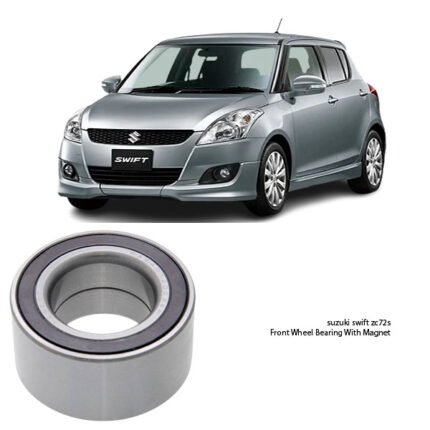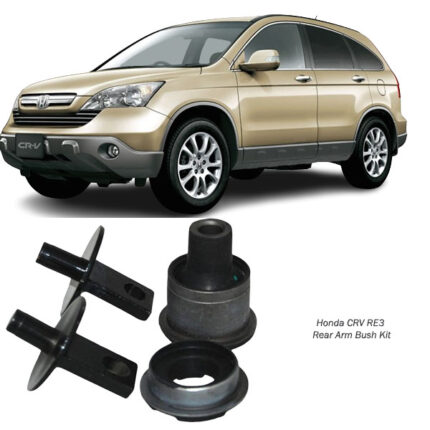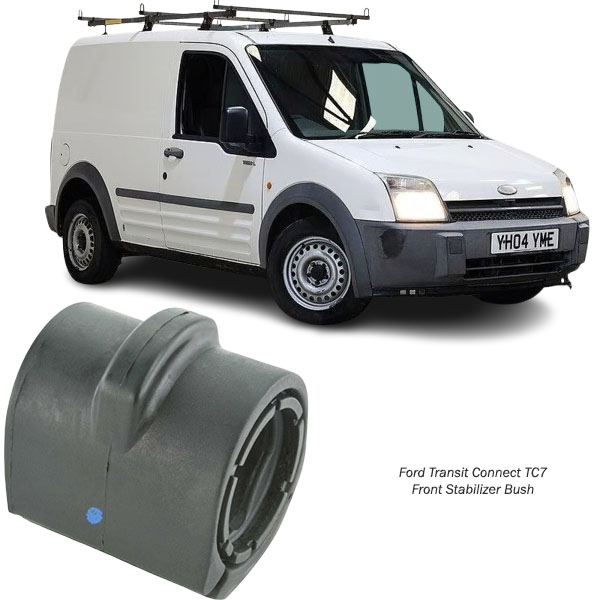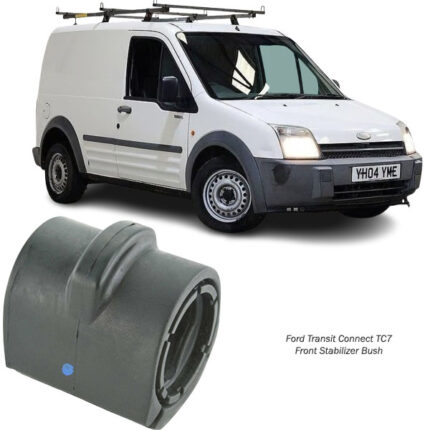Get Ford Transit Connect TC7 Front Stabilizer Bush FDSB-TC7F in Kenya
The stabilizer bush, also known as the sway bar bushing or stabilizer bar bushing, is a crucial component in a vehicle’s suspension system that plays a significant role in stabilizing the vehicle during cornering and reducing body roll. This bushing is typically made from rubber, polyurethane, or a combination of materials and is designed to absorb vibrations, reduce noise, and provide flexibility for the stabilizer bar (sway bar). Here’s an in-depth exploration of the stabilizer bush, covering its functions, importance, signs of wear or failure, and maintenance considerations.
Functions of Stabilizer Bush
- Attachment and Support: The primary function of the stabilizer bush is to securely attach the stabilizer bar to the vehicle’s chassis or frame. It provides a stable mounting point that allows the bar to pivot and move relative to the suspension components.
- Vibration Dampening: Stabilizer bushes are designed to absorb and dampen vibrations and shocks from the road surface. The rubber or polyurethane material of the bushing acts as a cushion, reducing the transmission of vibrations to the vehicle’s chassis and improving ride comfort for occupants.
- Noise Reduction: Alongside vibration dampening, stabilizer bushes help in reducing noise from the suspension system. By isolating the movement of the stabilizer bar, they minimize the transmission of suspension-related noise into the vehicle cabin, resulting in a quieter driving experience.
- Enhanced Stability and Handling: During cornering and maneuvering, the stabilizer bar transfers forces between the left and right wheels to reduce body roll and improve vehicle stability. The stabilizer bush ensures that the stabilizer bar functions effectively, enhancing overall handling and steering response.
- Maintenance of Suspension Geometry: A properly functioning stabilizer bush helps maintain the correct alignment and geometry of the suspension system. It keeps the stabilizer bar securely attached, preventing excessive movement or misalignment that could affect tire wear and compromise handling.
Importance of Stabilizer Bush
The stabilizer bush is crucial for several reasons:
- Safety: It contributes to the vehicle’s stability and handling characteristics, particularly during cornering and sudden maneuvers, which are critical for safe driving.
- Comfort: By reducing vibrations and noise, the stabilizer bush enhances ride comfort for vehicle occupants, making driving more pleasant, especially on uneven or rough road surfaces.
- Performance: Properly functioning stabilizer bushes optimize suspension performance, allowing for better handling, improved steering response, and enhanced overall vehicle dynamics.
Signs of Worn or Failing Stabilizer Bush
- Increased Noise and Vibration: Worn stabilizer bushes can lead to increased suspension noise, such as clunking, squeaking, or banging sounds, especially noticeable during cornering or over bumps. Excessive vibration felt through the vehicle chassis or steering wheel is also a common symptom.
- Handling Issues: A failing stabilizer bush can adversely affect the vehicle’s handling and stability. You may notice increased body roll during cornering, reduced steering precision, or a tendency for the vehicle to lean excessively in turns.
- Uneven Tire Wear: Misaligned or worn stabilizer bushes can cause uneven tire wear patterns, typically seen as excessive wear on the inner or outer edges of the tires. This not only shortens tire lifespan but also affects vehicle stability and fuel efficiency.
- Visible Damage: During routine inspections, check the stabilizer bushes for signs of wear, cracking, tearing, or deformation. Any visible damage indicates that the bushes are compromised and should be replaced promptly to prevent further issues.
Maintenance and Replacement
- Regular Inspection: Include stabilizer bushes in routine suspension inspections, especially if you notice any signs of wear or performance issues. Early detection of worn bushes allows for timely replacement and prevents potential damage to other suspension components.
- Timely Replacement: Replace worn or damaged stabilizer bushes promptly with high-quality OEM or aftermarket bushes designed for your vehicle’s specific make and model. Proper fitment and material choice (rubber or polyurethane) are crucial for longevity and performance.
- Professional Installation: Consider having a qualified mechanic or automotive technician perform the stabilizer bush replacement, especially if it requires specialized tools or equipment. Proper installation ensures that the bushes are correctly positioned and secured, maintaining suspension integrity and performance.
- Alignment Check: After replacing stabilizer bushes, perform a wheel alignment to ensure proper suspension geometry. This step optimizes vehicle handling, tire wear, and steering response, ensuring a safe and comfortable driving experience.
Follow us on Facebook for more parts.




